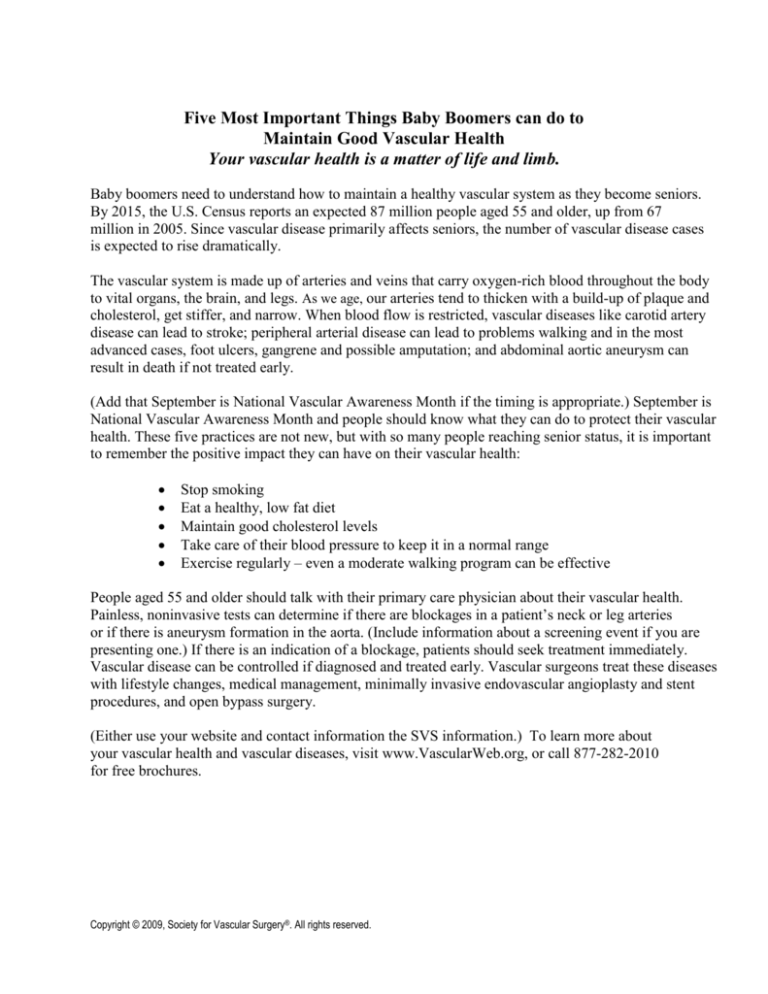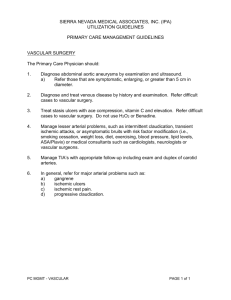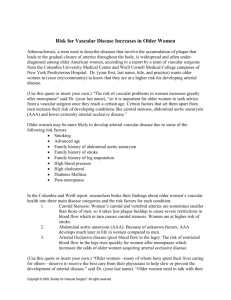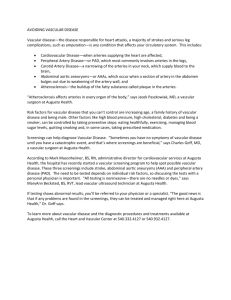
Five Most Important Things Baby Boomers can do to
Maintain Good Vascular Health
Your vascular health is a matter of life and limb.
Baby boomers need to understand how to maintain a healthy vascular system as they become seniors.
By 2015, the U.S. Census reports an expected 87 million people aged 55 and older, up from 67
million in 2005. Since vascular disease primarily affects seniors, the number of vascular disease cases
is expected to rise dramatically.
The vascular system is made up of arteries and veins that carry oxygen-rich blood throughout the body
to vital organs, the brain, and legs. As we age, our arteries tend to thicken with a build-up of plaque and
cholesterol, get stiffer, and narrow. When blood flow is restricted, vascular diseases like carotid artery
disease can lead to stroke; peripheral arterial disease can lead to problems walking and in the most
advanced cases, foot ulcers, gangrene and possible amputation; and abdominal aortic aneurysm can
result in death if not treated early.
(Add that September is National Vascular Awareness Month if the timing is appropriate.) September is
National Vascular Awareness Month and people should know what they can do to protect their vascular
health. These five practices are not new, but with so many people reaching senior status, it is important
to remember the positive impact they can have on their vascular health:
Stop smoking
Eat a healthy, low fat diet
Maintain good cholesterol levels
Take care of their blood pressure to keep it in a normal range
Exercise regularly – even a moderate walking program can be effective
People aged 55 and older should talk with their primary care physician about their vascular health.
Painless, noninvasive tests can determine if there are blockages in a patient’s neck or leg arteries
or if there is aneurysm formation in the aorta. (Include information about a screening event if you are
presenting one.) If there is an indication of a blockage, patients should seek treatment immediately.
Vascular disease can be controlled if diagnosed and treated early. Vascular surgeons treat these diseases
with lifestyle changes, medical management, minimally invasive endovascular angioplasty and stent
procedures, and open bypass surgery.
(Either use your website and contact information the SVS information.) To learn more about
your vascular health and vascular diseases, visit www.VascularWeb.org, or call 877-282-2010
for free brochures.
Copyright © 2009, Society for Vascular Surgery®. All rights reserved.
Three Most Prominent Vascular Diseases
Most Americans are familiar with heart disease and with the consequences of blockages in the vessels that
carry blood to and from the heart. But few people realize that blockages caused by a buildup of plaque and
cholesterol affect more than coronary arteries. Arteries and veins carry oxygen-rich blood to vital organs, the
brain, and legs. Blockages cause serious illness. Three of the most recognized
vascular diseases include:
Abdominal Aortic Aneurysm
Abdominal Aortic Aneurysm (AAA) is an enlargement or “bulge” that
develops in a weakened area within the largest artery in the abdomen. The
pressure generated by each heartbeat pushes against the weakened aortic wall,
causing the aneurysm to enlarge. If the AAA remains undetected, the aortic
wall continues to weaken, and the aneurysm continues to grow. Eventually, the
aneurysm becomes so large, and its wall so weak, that rupture occurs. When
this happens there is massive internal bleeding, a situation that is usually fatal.
The only way to break this cycle is to find the AAA before it ruptures.
Carotid Artery Disease - Stroke
Carotid arteries occur when the main blood vessels to the brain develop a
buildup of plaque caused by atherosclerosis, or hardening of the arteries. When
the buildup becomes very severe, it can cause a stroke. A stroke occurs when
part of the brain is damaged by these vascular problems; in fact, 80 percent of
strokes are “ischemic strokes” where part of the circulation to the brain is cut
off, usually due to blockages in the carotid arteries. The process is similar to
the buildup of plaque in arteries in the heart that causes heart attacks. Strokes
are the third leading cause of death in the U.S. according to the National
Center for Health Statistics.
Peripheral Arterial Disease
Peripheral arterial disease (PAD) occurs when atherosclerosis, or
hardening of the arteries, causes a buildup of plaque in the blood vessels
that carry oxygen and nutrients to all the tissues of the body. As these
plaques worsen, they reduce essential blood flow to the limbs and can
even cause complete blockages of the arteries. Early on, PAD may only
cause difficulty walking, but in its most severe forms, it can cause painful foot
ulcers, infections, and even gangrene, which could require amputation.
People with PAD are three times more likely to die of heart attacks or
strokes than those without PAD.
Provided by the Society of Vascular Surgery
Copyright © 2009, Society for Vascular Surgery®. All rights reserved.





